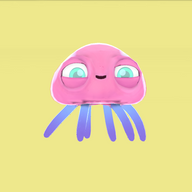Unit 12 : Jellyfish in motion
- Briony Davies
- Apr 9
- 6 min read
Updated: May 8
In the final unit of this module, we explore the motion and characteristics of a jellyfish swimming. Animating this fascinating marine creature presents a unique challenge, as it is our first experience with underwater dynamics in the module. The jellyfish's motion is characterised by its weightless floating and smooth gliding through the water. After reviewing the tutorials, the animation cycle is relatively straightforward, focusing on poses like squash and stretch to achieve a pulsating effect. Moreover, strong key poses and good timing is crucial to effectively convey the jellyfish's interaction with its watery environment. I looked at different videos of jellyfish to understand their movements in water. Jellyfish allow their bodies to move by floating with the current, and can create the force of movement from their body, causing their tentacles to follow through with the action My Science Blast (2023). There are also many types of jellyfish, and this rig provided is unclear of what kind of species it is, as it is more cartoon-stylised, so looking at a video from Nat Geo WILD (2018), showed various jellyfish with a brief background description of these creatures. It was a good insight into how they move in water, but as said previously, the rig is stylised, therefore I followed the tutorial closely but kept in mind the dynamics in the water.
Key poses from my own animation
To begin, I created a new project and scene, where I imported the rig into and saved as a new file. I opened the jellyfish or "jelly" rig and made some adjustments to the texture. The right eye had pre-existing issues that I was unable to solve, but I was able to adjust the texture by moving the UV map of the eye. This did result in one eye being darker than the other, but the previous situation was the right eye having two eyes in one. To continue, I set the frame duration to 33 frames and put in the main poses for squash and stretch. This cycle had very few keyframes, so the frames were created quickly. The longest part was animating the tentacles as it was repeated six times, with the back two having a negative orientation, so I could not copy and past the keyframes onto them unlike the others. I used the main control to animate the jellyfish rising up and then down. However, from previous tutorials, we typically avoid using this control in a cycle, but the character floating allows for it. A significant advantage of animating a marine creature is that there is no focus on the feet sliding on a surface, which makes the animation more manageable. The rig overall was very easy to navigate and had clear and simple controls for what the character did. I enjoyed developing the foundation for this animation and using this entertaining character.
To dive deeper into my process, I decided not to use various animation layers for this cycle as it was simple and didn't have many controls involved. I put key poses and in-betweens on frames 1,9,17,25 and 33. An element I added was additional animation on the tentacles. At frame 25, I rotated the tentacles outwards, and used the top individual control on the tentacles to bend them inwards. This allowed the motion of the body to look like it's pushing through the water. Then slight rotations were placed on the remaining tentacle controls and offset them by 2, to show fluidity and elegance. This was the more complicated element of this rig as there were multiple controls that needed adjusting. To add some detail, 'squinting' on the eyes were incorporated as the jellyfish squashes, as well as a smile to the mouth.
I've displayed two videos here, one showcases the keyframes using stepped tangents, allowing you to see a breakdown of my key poses. The next video is the final result with smooth and curved tangents that I edited in the graph editor. In the tutorial, it was suggested to bake out the frames; however, I only baked out the frames on the main control. I did this as the jellyfish in the animation was one simple cycle and I didn't add anymore addtional frames or motion. However the only change in the cycle was the movement of the jellyfish floating up (moving on translation Y on the main control). It felt unnecessary to spend time baking them out for a shot that wouldn't benefit from it. I only baked out the main control so I could move the creatures upwards as they swim, or spin and keep the rhythm.
To develop the animation further, I added in a set, taken from Turbosquid. This contributed to developing a narrative for my animation and added some excitement to it. In addition to adding in a set, and from my research, it was clear that jellyfish often swim in groups or "blooms", so I added in two more jellyfish to the scene. To create a twist in my shot, rather than having the jellyfish in the ocean, I placed them in a lava lamp, after being inspired by products of novelty jellyfish decor. I applied some Arnold textures to the lava lamp to resemble water and glass, and placed it accordingly in a bedroom with the sun beaming in. I drew inspiration from Disney and Pixar, particularly from Toy Story (1995) and Finding Nemo (2003). The underwater setting in Finding Nemo, filled with various fish and a jellyfish character, influenced my work by getting a sense of how marine creatures move in water. Additionally, I noticed that the rig used in my animation is similar to the character style in Finding Nemo, which influenced my approach to showcasing it. The inspiration for the set design came from Toy Story. I wanted to create a child's bedroom, with the jellyfish as the main focus. My intention was to portray the jellyfish as a group of characters reminiscent of the Three Little Green Aliens from Toy Story—happy and unaware of their surroundings, yet bringing joy to all.
The Final animation
This is my final animation. I'm happy with the result of the last animation in this module. It was straightforward and effectively conveyed the principles, such as squash and stretch, while also being a nice introduction to marine creatures. I believe I've showcased my work creatively and engagingly, even if set design, camera work, and lighting aren't my strongest skills. Moreover, I feel confident in the methods and processes suggested and in organising my work in an effective and efficient way, especially since the beginning of this module, making less room for error and more time spent on the animation. I especially feel confident in baking out the keyframes and using the settings/options box to my advantage and making my workflow better. To push this work further, I could add more elements to the animation itself or more variation. The animation cycle was simple, so there is definitely room to include more and create that sense of individualism. For example, I could create more of a personality for the character and push the story, such as the jellyfish waking up and finding itself trapped, beginning to panic, swimming across the water, up and down, to then a sudden stop as the camera pans out to reveal the jellyfish is stuck in this lava lamp container. This would allow me to incorporate the swim cycles as a part of the animation, rather than it being the whole of the animation.
Reflections and Refinements
As I reflect on my final animation of this unit, I feel proud of the level of work I have produced and the explorations of various cycles and methods. The animation is probably a more straightforward cycle compared to the previous ones I have animated, making it a nice way to end this module. Upon feedback, the animation seemed to have positive reviews, but I do feel I could have made the cycle loops flow better into one another as it is obvious in the jellyfish loop motion. Maybe it would have been beneficial to bake out the keyframes and make adjustments to avoid this. I also had a technical issue with the Arnold render and the jellyfish mesh, as it was not renderable. I tried to troubleshoot this and thoroughly check the settings of the geometry and texture, as well as the Arnold settings, but everything was as it should be to render out, and yet the jellyfish was black, even with no background and Arnold lights applied. I was unable to fix this in time for the end of the module; therefore, I rendered out using Maya 2.0, which does show the difference in quality compared to my other animations, but it was the only option. I do think this animation was a fun and entertaining cycle to create and showcase.













Comments